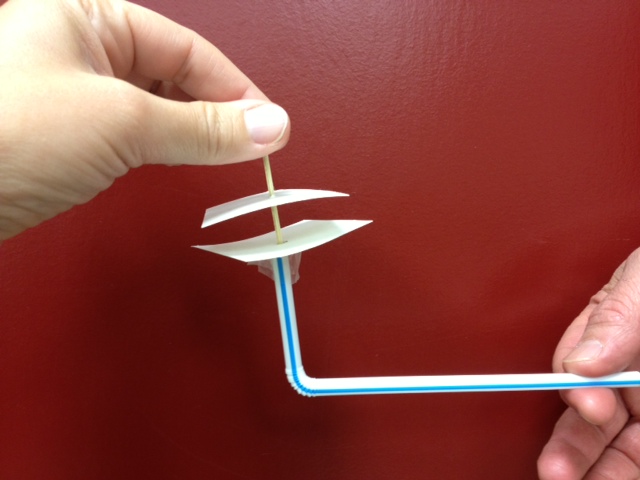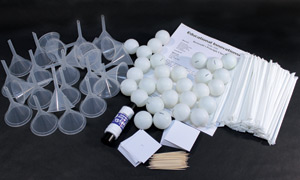 by: Tami O’Connor
by: Tami O’Connor
A few weeks ago my daughter, a new fifth grade teacher, asked me to come into her school to present a hands-on science lesson on Bernoulli’s Principle. Nothing delights me more than working with kids in a classroom. After 16 years of teaching, it’s hard to be away from it. At first I was unsure what I was going to bring in. I have so many really neat activities at my disposal that it is difficult to select just one. I finally narrowed it down to activities dealing with air pressure, which is part of their curriculum (always a plus!).
 As I rummaged through the office, I unearthed my supply of funnels, flex straws, and ping pong balls and decided that Daniel Bernoulli would be my guest of honor that day. When I started my lesson, I blew up a balloon and talked about air and its properties. Inviting comments, I discovered that they had some very interesting background knowledge, and most of it was correct…
As I rummaged through the office, I unearthed my supply of funnels, flex straws, and ping pong balls and decided that Daniel Bernoulli would be my guest of honor that day. When I started my lesson, I blew up a balloon and talked about air and its properties. Inviting comments, I discovered that they had some very interesting background knowledge, and most of it was correct…
Bernoulli’s Principle Lesson: WindTube
I then pulled out another balloon, only longer and made from plastic rather than latex. It was actually a WindTube; our eight foot long Bernoulli bag! My first question was, how many breaths would take to inflate the wind tube? Guesses ranged from 50 to one million. It was, after all, a group of ten year olds… I bunched the end and brought the bag to my mouth. I decided to put just 5 breaths into the bag, and then after pushing all the air down to the bottom of the windtube, we estimated how many additional breaths it would take to completely fill the bag.
 As it turned out, had I filled the bag the same way I started, it have would taken about 45 of my deep breaths to inflate it fully. At this point I threw out a challenge: if anyone in the classroom could inflate the bag using their breath faster than I could I would give the entire class the rest of the day off to play outside. Well, as you can imagine, the kids began to assemble their “dream team”. I explained they could only select one person as my opponent. They put forth the captain of the swim team explaining that his lung capacity was better developed than any of his classmates. We stood back to back, and we each had a teammate holding the far end of our windtube so the spectators could track our progress.
As it turned out, had I filled the bag the same way I started, it have would taken about 45 of my deep breaths to inflate it fully. At this point I threw out a challenge: if anyone in the classroom could inflate the bag using their breath faster than I could I would give the entire class the rest of the day off to play outside. Well, as you can imagine, the kids began to assemble their “dream team”. I explained they could only select one person as my opponent. They put forth the captain of the swim team explaining that his lung capacity was better developed than any of his classmates. We stood back to back, and we each had a teammate holding the far end of our windtube so the spectators could track our progress.
One student in the class was selected to announce, on your mark, get set, and GO! At that point I started faking the sound I would make if I were actually trying to inflate the bag, to fool my opponent into thinking I was working really hard. After he had put about 6 breaths into his bag, I stood back and held my bag at arm’s length with the mouth of the tube wide open and blew a long steady stream of air into the opening of the bag. Within seconds the entire tube was filled. At this point all the kids in class began to giggle since the swim captain was turning red and still working relentlessly to inflate his bag.
Why did this happen? According to Bernoulli, a fast moving column of air creates a decrease in air pressure. Only a small percentage of the air in the bag came from my lungs. The rest was drawn from the room. As I increased the speed of the air I directed into the opening of the windtube, the pressure around it decreased and more air was drawn into the bag.
Bernoulli’s Principle Lesson: Funnel and Ping Pong Ball
Ok, so now the class totally understood the concept, and it was time for the next activity. I gave each student a flex straw, a funnel, and some clear tape. They were instructed to attach the narrow end of the funnel to the short end of the straw using the tape. I assured them that the funnel and straw did not need to fit snugly. The tape connected the two pieces kept any air from escaping. I asked the students to place their hand above the opening in the funnel, blow into the straw, and tell me what they felt.
As expected, the kids felt their breath exiting through the wide end of the funnel. Now, with their new-found knowledge of how fast moving air creates low pressure, I asked the students to predict what would happen if they put a ping pong ball into the opening of their funnel and then blew into the straw. Each and every one of them predicted that the ball would be blown out of the funnel! Some even went so far as to boast that their ping pong ball would hit the ceiling (of course they stipulated that they had to be standing rather than sitting at their desks).
Many times in my teaching career I wished I had brought a camera into my classroom. That day was one of them! When I counted to three, every face in the room turned red while they tried with all their might to blow that ping pong ball out of the funnel. Of course, the ping pong ball wasn’t going anywhere. Bernoulli’s Theorem, also known as Bernoulli’s Principle, states that an increase in the speed of moving air (or any flowing fluid) is accompanied by a decrease in the air or fluid’s pressure. The airflow around a ball or other curved object placed in an airstream will increase its speed. When the air increases its speed its pressure decreases. The low air pressure created around the ball allows the high pressure from above the ball to push the ball back into the funnel.
Bernoulli’s Principle: Straw, Toothpick, and Oak Tag
Ok, so after the students were able to explain this concept to me we moved onto the next activity. Using the same straw, I gave them each two pieces of 1.5” x 1.5” oak tag and a toothpick. One piece of oak tag was hole punched in the middle, and I instructed the students to attach the card to the short end of the straw so that the hole was flush with the end of the straw and it looked like a tabletop.
I asked them to secure the bottom of the card to the straw using tape. Next, I pushed a toothpick through the center of the second card and placed the two cards together with the toothpick protruding into the straw. The next challenge… What would happen when I blew through the straw?
Surely, after the last two demonstrations they would get this one. Only one lone student hypothesized that the cards would remain together. The others insisted that the cards would fly apart, but because of the toothpick the second card would fly straight up. How I wanted to cringe. Needless to say, the class (well, all but one) was amazed that no matter how hard they exhaled into the straw, the cards remained together. The only thing that was even more impressive was when I instructed the class to rotate their straws 180 degrees, while holding the second card in place, and to blow.
As they blew a steady stream of air into their straws I had them remove their hands. Then the excitement became even more apparent as the cards still remained together! Well, at least until they stopped blowing to try to get my attention. By this point the kids were all able to explain that the card remained in place, defying gravity, because the decreased air pressure between the cards allowed the higher air pressure from within the room to force the cards together.
Bernoulli’s Principle: Hanging Ping Pong Balls Activity
The final activity involved the straw, two ping pong balls, a 12-inch piece of kite string and some tape. Working in pairs, the students attached one ping pong ball to each side of the string with tape. While one student held the string with the ping pong balls hanging approximately 1 cm apart, the second student blew a steady stream of air between the two.
As they had predicted, rather than moving apart, because of Bernoulli’s Principle, the spheres actually moved together! Phew! Though it took a little while, the concept was finally clear in their minds. A fast moving column of air creates a low-pressure area and draws other objects in.
As I left the classroom, the students were trying to come up with other ways to demonstrate how Bernoulli’s principle could be demonstrated. It just doesn’t get better than that! Once I returned to the office, I realized that, though all the materials are fairly common, they not always found together. So I put a kit together, and we now produce it at EI. With the exception of the Windtube, the Bernoulli’s Principle Class Kit has all the materials you will need to conduct the activities mentioned above with a class of 25 students.




I love this! I’m going to try this with my adult learners. reading about Bernoulli’s principle just doesn’t cut it for everyone.
Thanks a million.
Rob
Hello. I was wondering what are two things that use Bernoulli’s Principle outside of classrooms. I need to know asap please. So can you email me when you get a chance.
This worked great with several different elementary school levels. The straw, toothpick and oak tag (or card stock) lesson was too tedious for the younger grades. They could not tape the piece of card stock with the hole in it flush with the top of the straw, so it wouldn’t work. Also, beware of safety issues with flying toothpicks! I used goggles.
Thanks for writing! I’m happy to hear that you were able to use this activity with students. I do love air pressure experiments. It’s always fun to watch the kids as they discover some things that they didn’t expect to see. I certainly agree, Goggles are always a good idea! As with any activity, you have to watch carefully that all items are being used properly.
~Tami
Educational Innovations